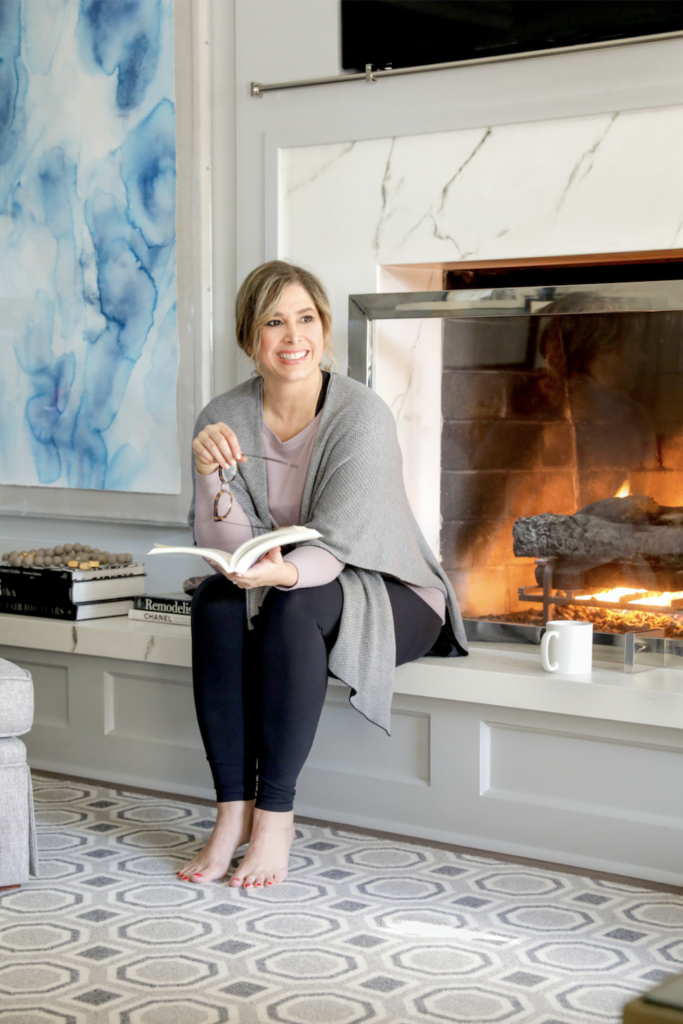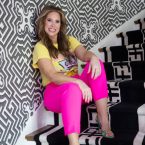Your home greatly impacts your productivity, your profitability, your habits and so much more.
Over the years, I’ve expanded my work in interior design beyond just the pretty parts. What interests me is what makes our homes more functional, productive, and organized, which creates a better quality of life and sense of wellness for us. And I don’t think this part of interior design gets near enough attention.
We can absolutely set ourselves up for success with less stress and more wellness, productivity and profitability and that’s just the beginning. So have you engineered your home or work space for productivity? And did you even realize you could?
Today I want to cover four areas in our homes that I think have the most potential to make or break our success. And for a lot of us, our homes are holding us back and we don’t even know it or realize it.
Is Your Home Stressing You Out?
Do you find yourself saying things like: I am SO busy, SO tired, SO overwhelmed? Ultimately, all those things are code for: I am so stressed.
We think the stress is coming from our work or our relationships—and yes, those play a huge role, but how might our homes be stressing us out? Or at least, how is our stress not being taken care of in our home environment?
If you think you have to go on a vacation to de-stress—then I can guarantee that your home and work spaces aren’t working for you in the ways that they could.
First, there is the clutter. And yes, Marie Kondo thankfully has turned a big ole spot light on this one. But I think we now sort of poke fun at the Kon Mari method but aren’t realizing how much not being organized is adding to our stress and also impacting our finances.
Physical clutter equals both visual and mental clutter. And all those things increase our stress. How? Well let’s count the ways…
- There is the fact that you now have to add a lot more items on your to do list to deal with all the clutter. Think about it, the more stuff you have, the harder it is to keep your home or office clean.
- There is also the lost time and money of looking for things that don’t have a specific place to live. Americans spend almost 3 days a year looking for lost items and billions of dollars replacing things that are lost. Besides the toll that losing something takes on us emotionally—most of us get angry and stressed when we can’t find something. And it’s even worse when you are late to work or an appointment and so often those go hand in hand, right? Like I am late for work and can’t find my—keys, phone, shoes—the list goes on.
- Then, there is the anxiety that visual clutter creates for most of us, and we may not even know that’s why we are anxious. But it is definitely harder to relax when spaces are not tidy and clean.
And clutter isn’t the only thing in our homes that feeds into stress.
A poorly designed or dated space adds stress. Lack of storage, inefficiency of the layout of a room where it’s harder to function or takes longer to function adds stress.
For example, before we renovated our home, I was stressed daily by the kitchen cabinetry that wasn’t deep enough for my plates and the shelving wasn’t adjustable, so many of my large pots wouldn’t fit in the lower cabinetry. Trekking to the garage or the attic to get cookware every day wasn’t my idea of fun!
So think about all the things that “don’t work” in your space that make you crazy—broken drawers, rooms that don’t accommodate your furniture, not enough closet space, and bad lighting. Lack of interior insulation, “thin walls” where sound carries too much. Low bathroom counters—they are hard on your back. Or what about when there is not a great space to control laundry, or trash and it piles up? These things need to be out of site and contained for less stress.
There are so many opportunities for poor design to be adding stress to our days and we don’t even realize it’s taking a toll.

How Your Home Can Help You De-Stress
All those examples are what our home does to add stress, but what about what it can do for us to reduce stress? Function, layout, having certain zones like a space to detox, decompress, rest, meditate, exercise—these activities are all huge stress relievers!
Curbing clutter and improving design is actually one of the best ways to reduce stress. You can even do simple things in your home like have the right scented candles or essential oil diffusers (think lavender) to reduce stress. So it doesn’t all have to be expensive like moving walls. It might just mean a trip to the container store to take stress down.
And having beautiful and comfortable spaces to connect with those we love can bring our blood pressure down several notches, too. There are dozens of ways that our home can be our ally against stress. But for many of us, we have never even thought about that.
This stuff is important, friends. It makes a difference in how you and your family show up at work, at school and in life. (If you want to get a jumpstart on improving your home now, get your free copy of my Home Design Blueprint—it’s filled with resources to help you optimize your space right away. Get your free copy here!)
Is Your Home Preventing Productivity?
Maybe you know you need to get organized. But you likely aren’t realizing that those goals you are missing, could also be due, in part, to your environment.
If your home doesn’t allow you to focus, it’s preventing your productivity, especially If you work from home some or all of the time. And what about your kids productivity when doing homework or studying for a test?
Clutter again may be an issue but also other distractions that keep you from following through are playing a part too. When there is too much to do “around the house” it’s hard to get focused on your real work.
And if your work space or zone is too hot, too cold, too noisy, too bright, too dark, has too many electronics like a TV, is in a high traffic zone or hub of the house—it’s going to be hard to get your work done!
If you don’t have an attractive work space that is enticing to spend time in, it’s so much easier to lay on the couch and binge watch your favorite Netflix show or scroll social media on your phone. And that’s the opposite of productivity.
How Your Home Can Boost Your Productivity
You want to create a work space that is attractive, so it draws you in and you create the habit of regularly showing up and being ready to work. Whether it’s making your office attractive by the layout and décor, or making your desk attractive with fresh flowers, or great office supplies, or a comfy chair, or situating your office in a room with the perfect amount of sunlight and a gorgeous view, anything that you can do to make your workspace more enticing to be in (vs. the couch and the remote control), is going to do wonders for your productivity.
There is a lot in the area of color psychology that plays a role in productivity.You want a color that doesn’t agitate you but also that doesn’t make you too lethargic. Something in the middle that is energizing but still refreshing and nurturing. Some yellows are great for productivity as well as blues.
Interestingly enough—grays have been so popular in interior design for the last 10 years but gray isn’t necessarily great for productivity. It can be too drab and depressing for many people. And white can be too stark. So pay attention to the color of your space depending on the outcome you are looking for, like productivity. And lighting plays a HUGE role in your productivity and in the way colors look, too.
Fluorescent lighting is draining emotionally and can make colors in a space distorted which can further impact your mood or output. You want natural sunlight or lighting quality that simulates natural light or both. You need enough lighting to safely and effectively do the tasks on your list or schedule. I also like layered lighting, like lamp lighting or what’s called ambient lighting, as it is more soft and comfortable than overhead lighting so it makes me feel happier and more nurtured. Start to notice how lighting makes you feel.
Equally important is air quality. I am more productive when I can open a window or even take breaks outside to get fresh air. Also the air temperature is important for productivity—too cold is distracting and too warm can even put you to sleep.
And finally, one other thing to think of with productivity is what I call “home systems”—all the things that support an activity or task in your home. We think of systems at work, but we rarely think of them in our homes.
For productivity, planning all the things you will need to be effective at your work in the spaces you will be working in is key. Otherwise there are too many interruptions looking for things, making trips to other spaces to gather needed items or tools. The most important step is gaining awareness of distractions so you can find solutions for them in advance of sitting down for focused periods of work. I go deeper into this in my Home Design Blueprint – download your free copy here.
Is Your Home Supporting Your Health and Wellness?
Your home definitely impacts your sleep, right? Which impacts both your physical and mental health. A lot goes into a good night’s sleep—the mattress, sheets, bedding and pillows. The temperature of the room. The lighting (or darkness—hello black out curtains) and removing blue light that can disrupt your circadian rhythms. It takes careful consideration of your sleep space to optimize your rest.
Self-care is also much needed for optimal wellness. Have you designed your spaces to promote self-care like meditation, epsom salts baths, an infrared sauna, yoga, rest, detoxing from electronics?
It is possible to integrate health into your workspace, too. Do you have an adjustable sitting to standing desk in your work space so you don’t sit too much—they say that sitting is the new smoking? What about an ergonomic chair that supports your body most effectively. The perfect chair is specific to each of us and how tall we are, how we are shaped, where we need the most support? I tend to like working from my bed because it’s comfortable, but too long in that space and my back and hips hurt, so my desk chair is important for longer periods of focus and effectiveness.
Itt only makes sense that the healthier, happier and more relaxed you are, the more productive you will be and your environment plays a huge role in how you feel.
How Your Home Can Make You More Money
We all want more money right? So are our spaces setting us up for this result? What keeps us from being profitable?
Well, not being productive. Not spending time on the right things—the things that make us the most money. Not having time or space to generate new profitable ideas. Not starting our days off effectively or knocking out the most important stuff before we get distracted or interrupted.
And each one of these things can be enhanced or supported by our environment.
So think about creating a space in your home that is distraction-free and that nurtures you to create your best ideas—I call this the “idea incubator.”

Also see if you can design your home to entice you to follow through on your morning routines, instead of staying in bed. I designed my morning routines around my favorite chair in my living room, and in the winter, I turn on the fireplace, I make my favorite bulletproof coffee in my favorite mug and have my favorite journal and favorite blanket to cuddle in. Instead of sleeping in, I am motivated to head from the bed to that chair, and am so happy to start with my quiet “me time” every day.
How can you entice yourself to follow through in this way by designing your environment to support you? Can you see how you can increase your profits by following through on your morning routine which sets the tone for your whole day?
We can absolutely set ourselves up for success with less stress and more wellness, productivity and profitability all with the way we design our spaces at home and at work.
But it doesn’t happen by accident. You have to make this happen by design. So dig into assessing your space and see where you can take your results to a whole new level.
If you want to go deeper into designing a home that truly supports you, I created a few free resources, filled with more easy-to-follow tips and advice to create the home of your dreams. Once I started following these steps, I saw my income double in less than a year! Get your free Home Design Blueprint now!
xo,













